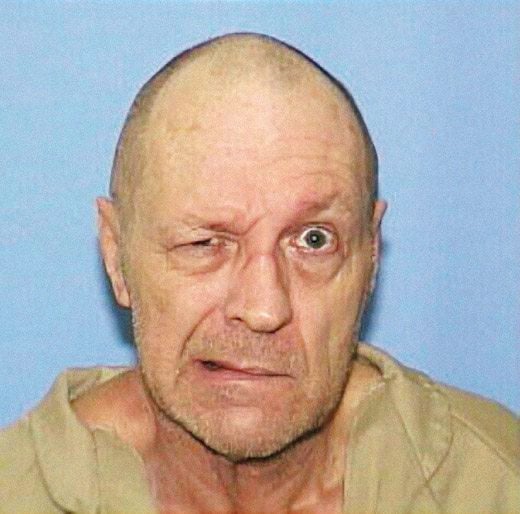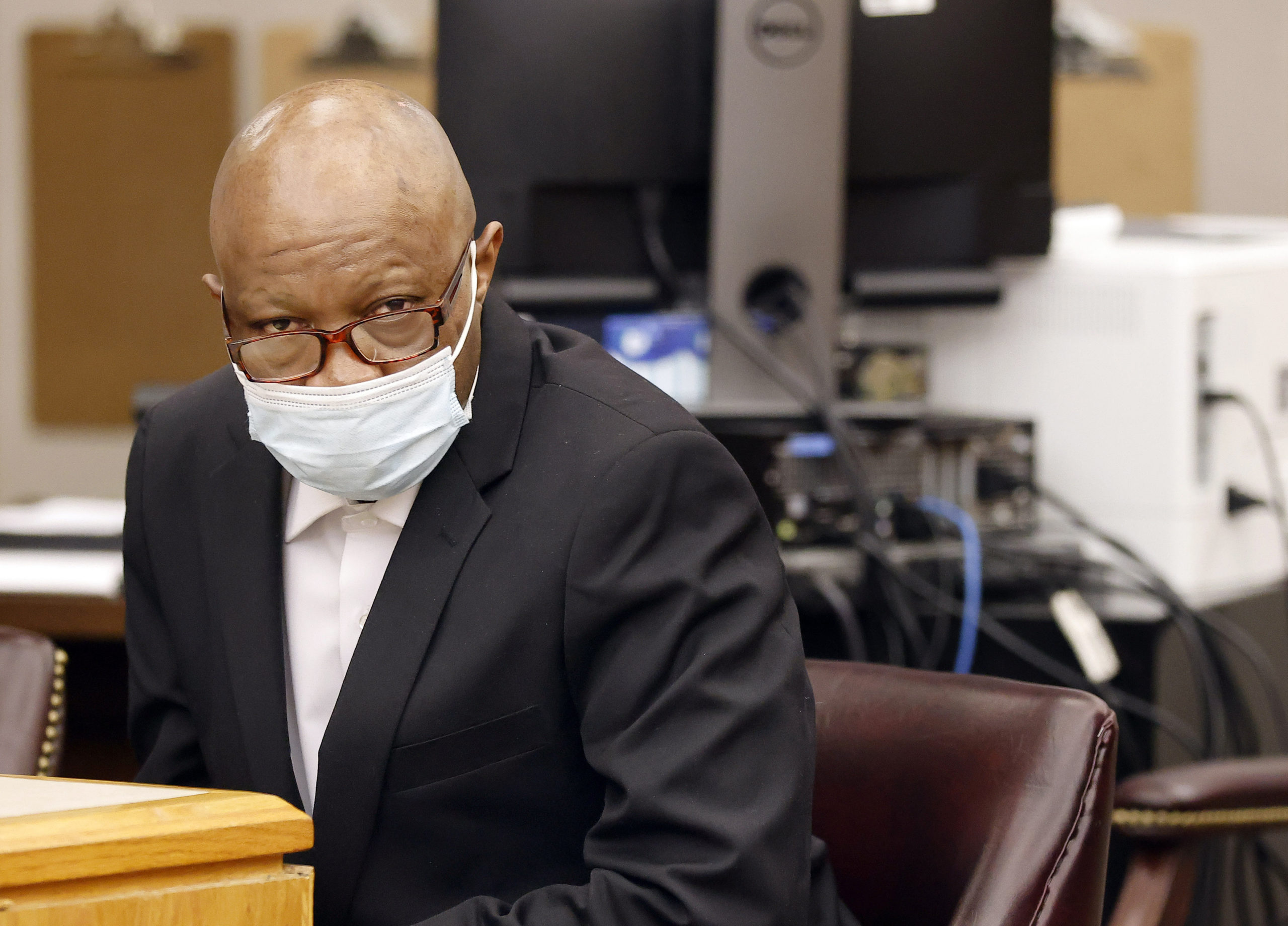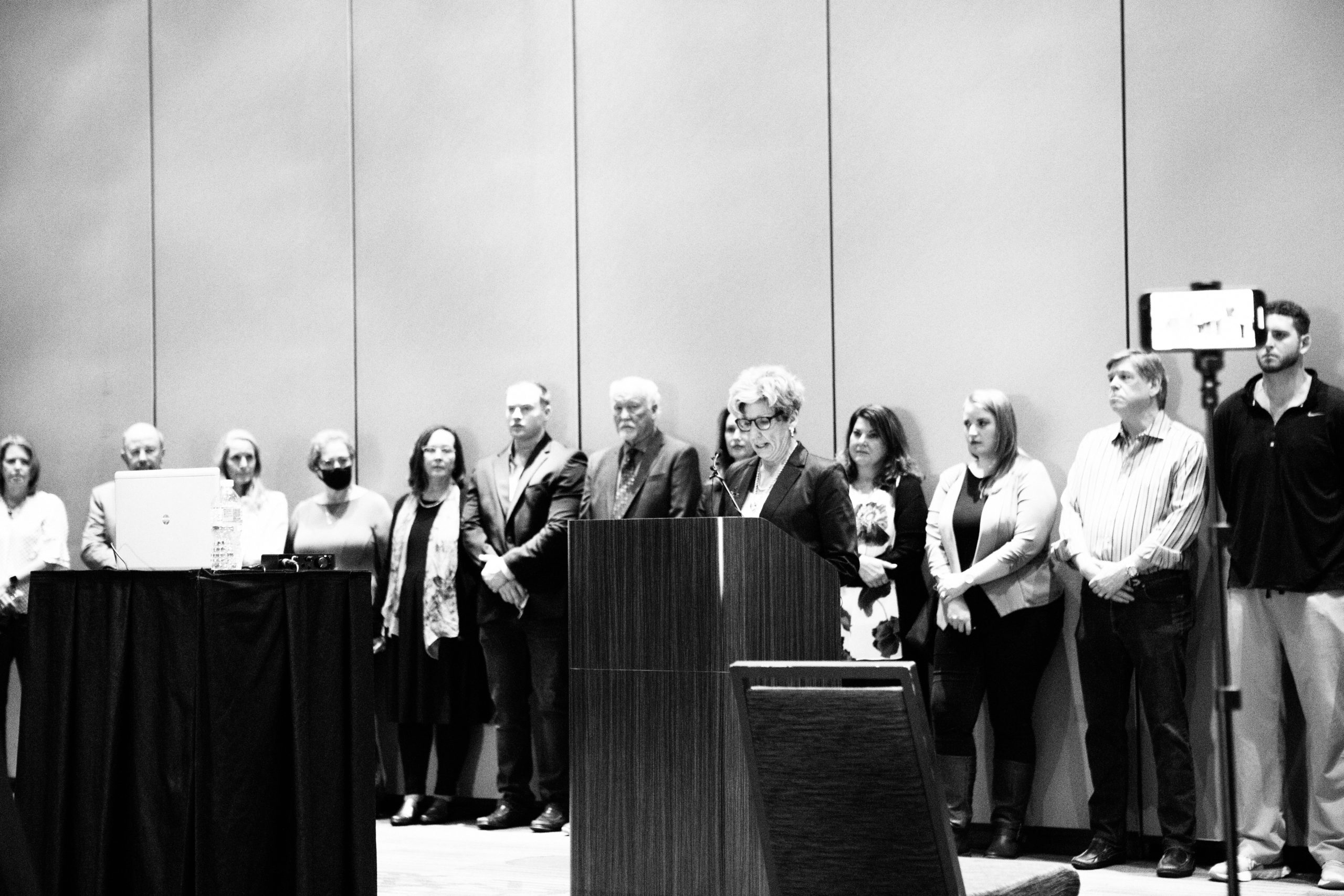
Highway Injustice
Texas leads the nation in unsolved serial highway homicides. Could interstate cooperation deliver closure?

The picture shown to the jurors was enough to haunt them for a lifetime: a young girl with jet-black hair and pale skin, standing amid the tumbledown ruins of a wooden barn in rural Illinois. She wears a dress that reaches to just above her knees and patent leather heels. She is staring at the camera, her hands held up like she’s fending off an attacker. Sometime after the photo was taken, 14-year-old Regina Walters, a runaway from Pasadena, Texas, was strangled with baling wire and her body abandoned in that same barn.

The person who took the photo—her killer—is Robert Ben Rhoades, a long-haul trucker from Houston. In April 1990, five months before Regina’s decomposed body was discovered, Rhoades was arrested on the shoulder of Interstate 40, about 50 miles north of Phoenix. A state trooper, who thought Rhoades was parked dangerously, discovered a woman inside the truck, alive, but shackled to the door. She had welts on her body, cuts on her mouth, and a horse bridle secured around her neck. In Rhoades’ briefcase, investigators found alligator clips, leashes, handcuffs, whips and dildos. He had told his latest victim—the woman in the cab—that he had been torturing women for 15 years as he crisscrossed America by highway.
Rhoades was sentenced in Illinois to life without parole. But in March of this year he was transferred to Ozona, Texas, where he appeared in court charged with the 1990 murders of two hitchhikers. Twentysomethings Douglas Zyskowski and his new bride Patricia Walsh had been on their way from Seattle to Georgia when Rhoades offered them a ride near El Paso. Zyskowski’s remains were found in January 1990, some 300 miles east of El Paso, along Interstate 10 near Ozona. Walsh’s corpse was discovered in October 1990 by deer hunters in Utah. Detectives didn’t identify Zyskowski’s body until two years after the grim discovery; dental records helped authorities identify Walsh 13 years after her murder.
Though prosecutors in Texas initially indicated they would seek the death penalty, Rhoades ended up accepting two life sentences under a plea deal: if for any reason he got out of prison in Illinois, he would be behind bars in Texas for the rest of his life. Rhoades, in his 50s and balding, wearing glasses and a squint, stared straight ahead as the judge read his sentence. After the trial, prosecutors told the media they suspected Rhoades may be responsible for additional murders. Trucking records showed he regularly traversed 22 states. The FBI won’t comment on its ongoing investigation.
The agency believes there are currently close to 300 “highway serial killers” like Rhoades at large in the U.S. Crisscrossing the nation in big rigs, they are unconfined by city, county and state boundaries. Because the cabs of their trucks are their killing fields, the chances of finding DNA evidence tying a particular truck to a body that’s been tossed out the door are next to none.
In her book Killer on the Road: Violence and the American Interstate, published by the University of Texas Press in April, author Ginger Strand writes that highway violence followed hard on the heels of the construction of the U.S. interstate system, beginning in the 1950s. “Before the concrete was dry on the new roads,” she writes, “… a specter began haunting them: the highway killer.”
In the 1980s the FBI launched an initiative called the Violent Criminal Apprehension Program, better known by its acronym, VICAP. Local law enforcement agencies can fill out a 16-page form indicating the characteristics of a particular homicide. The form can be sent to the FBI, where analysts look for patterns. Submitting murders to VICAP, however, is not mandatory.
In 2004, the agency launched its Highway Serial Killings initiative, creating a repository specifically for information about serial murders gleaned from law enforcement agencies nationwide. By 2009, the initiative had identified 600 victims and upwards of 275 suspects.
Two years ago, FBI statistics showed Texas leading the nation in unsolved serial highway homicides. According to a USA Today investigation, the FBI believes serial killers operate along the busiest stretches of highway in the nation.
Catching truck-driving serial killers may not be easy, but I wanted to find out how far we’ve come in solving such crimes. What I discovered was an inter-institutional mess in which law enforcement agencies hardly communicate with each other, leaving murders unsolved, families without closure, and killers on the loose. What’s more, the 38 unsolved highway serial murders the FBI has identified in Texas could be a drop in the ocean compared to the actual figure.
In December, 2011, I contacted the FBI in Quantico, Virginia, for details of some of the Texas cases. Special Agent Ann Todd told me via email that since the cases in the database did not originate with the FBI, the agency couldn’t disclose specific information about individual crimes, including locations, “or the names of the law enforcement agencies responsible for the investigations.”
“As a point of clarification,” Todd added that submissions to the agency’s Highway Serial Killings database were, like those to VICAP, voluntary, so a higher number of murders reported by one state is not necessarily indicative of a greater crime problem there. By that same token, reported figures are likely to be smaller than the real number, because law enforcement agencies are under no compulsion to notify the FBI.
Surely the Texas Rangers, tasked with the state-wide investigation of unsolved serial crime, among other things, would be able to help? The Texas Department of Public Safety, which includes the Rangers, told me they did not have a centralized cold-case unit, and therefore probably didn’t have the information I needed. “We do have Rangers who work on cold cases in various areas, often assisting local agencies, but there is not one central agency.”
I was left with the local agencies, sheriff’s offices and police departments in municipalities throughout Texas, but aside from contacting each of them individually (there are 1,067, by my count), it’s impossible to get an accurate idea of how many serial murder victims there may be in this state—let alone the other 49. If a highway serial killer were to dump a victim this side of the Oklahoma state line and another victim on the other side, there’s little chance that police in the bordering jurisdictions would talk to each other; ergo no serial killer. We have no comprehensive idea how many victims of serial murder there are, let alone how many perpetrators. As the FBI’s Todd told the media in 2009, “The mobile nature of the offenders, the high-risk lifestyle of the victims, the significant distances and involvement of multiple jurisdictions, the lack of witnesses and forensic evidence combine to make these cases almost impossible to solve using conventional investigative techniques.” In many cases, they are impossible to solve at all.
Regina Walters’ father received anonymous phone calls a month after her disappearance.
The calls were traced to Oklahoma City and Ennis, Texas. “I made some changes,” the voice on the phone told him. “I cut her hair.” Among the evidence recovered from Rhoades’ truck after his arrest in 1990 was a notebook belonging to Walters in which she had written her father’s phone number. Detectives compared Rhoades’ trucking logs with the phone calls, placing him in Oklahoma City and Ennis when the calls were made. In Rhoades’ Houston apartment, police found handcuffs, whips, bondage magazines and white towels soaked in blood.

Rhoades had been arrested in early 1990 for a similar kidnapping in Houston, in which he kept an 18-year-old girl in the cab of his truck for two weeks, shaving her pubic hair (he’d done the same to Regina Walters before killing her) and raping her before she escaped. In the Houston case, according to a story in Tuscon Weekly magazine, the victim was too scared to identify Rhoades for police and he was allowed to go free.
In prison in Illinois for Walters’ murder, Rhoades was then indicted—on the basis of DNA evidence—for the murders of hitchhikers Zyskowski and Walsh. Laurie English, the District Attorney for Pecos County, which includes Ozona, called it among the worst crimes she had ever prosecuted. Had Rhoades not parked at the side of an Arizona highway with his hazard lights on that April night 22 years ago, he might never have been caught at all.
Jack Levin, author of one of the first books about serial killers—Mass Murder: America’s Growing Menace, published in 1985—tells me that serial killers tend to stick to established comfort zones and often live in the community in which they commit their crimes. For long-haul truckers, the comfort zone is the cab of their truck. “Their victims, usually prostitutes, are picked up at truck stops and dumped along a desolate area of a highway,” Levin says. (According to the FBI, victims of highway serial murderers are typically women who live high-risk, transient lifestyles, and are often involved in drug and alcohol abuse and prostitution. Their bodies, the agency says, are often left in rural areas along highways, distant from the jurisdiction or even the state in which they were picked up. Walters, Zyskowski and Walsh did not fit this profile.)
University of Houston criminology professor Steve Egger, a former homicide detective, calls such victims the “less dead.” Prostitutes, he says, make appealing targets for serial killers because they are often socially marginalized, with no one to notice they’ve gone missing.
The bookshelves in Egger’s Houston office are stacked with tomes on crime victims, crime analysis, crime mapping, even serial killer cinema, plus biographies of some of the better-known mass killers. Considering there are supposedly so many truck-driving serial killers out there, I tell Egger I’m struggling to name even one, other than Rhoades. “Keith Jesperson out of Oregon,” he says, quick as a flash. Jesperson, who became known as the Happy Face Killer due to the smiley faces he drew on letters to the media, killed eight women in the Pacific Northwest in the early 1990s.
There have been others too, he says. In 2010, an Illinois trucker named Bruce Mendenhall was found guilty of the murder of 25-year-old truck-stop prostitute Sara Hulbert in Tennessee after police discovered her bloody clothing in a plastic sack in the cab of his truck. Detectives later found the blood of five different women in Mendenhall’s cab, and Mendenhall is suspected of several additional murders, including one in Texas. He is due to stand trial for the murder of a Tennessee woman later this year.
Egger coined the term “linkage blindness” to describe what he says is the inability of law enforcement agencies to recognize serial murder patterns. “They are myopic,” he says. “They act like these [killers] don’t have a car or don’t have legs. Serial killers may not be Mensa members, but they become aware of this fact.”
Egger once interviewed Henry Lee Lucas, one of America’s most prolific serial murderers. “Lucas claimed he carried bodies across jurisdictions because he knew police forces didn’t talk to each other,” Egger says.
And bodies, he says, may be outnumbered by crime scenes: “You might be talking about a place where the victim was lured, where they were held, the place where they were killed, the place where they were dumped, and the place where the weapon was discarded.
“By the time patterns are identified, by the time they’ve found a similar modus operandi or trace evidence, there could be eight, 10, 12 victims, and the traditional response is to form a task force. But if they think task force, they think task force within their own agency.” If an interagency task force is formed, there’s inevitably controversy over who’s going to be in charge, Egger says, and who’s going to take credit if the killer is found. “It’s almost childish, but it happens all the time.”
Recent events in Long Island, New York, seem to echo that dynamic. Since 2010, 10 bodies have been discovered in undergrowth lining the ocean-front of Jones Beach, but for months police refused to consider that the murders could be the work of one killer. The gravesites stretched across county lines. Detectives in both counties now accept that the murders were likely the work of one man, who remains at large.
According to the American Trucking Association, there are roughly 3.5 million truckers on the road today. In her book, Ginger Strand identifies about 25 former truckers currently serving time in U.S. prisons for multiple murders. She quotes Eric Hickey, dean of the California School of Forensic Studies at Alliant International University, describing truck-driving serial killers as “opportunistic.” Part oft the problem may be truck stops themselves, which Hickey describes as “absolutely fascinating places for criminal activity.”
Not least due to lack of witnesses. Pit-stopping travelers tend not to pay much attention to their surroundings, Egger says. “You might have to go to the bathroom, maybe grab a candy bar or a cup of coffee if you are getting sleepy, and then you are gone. You won’t even remember what the gas station looked like, let alone any of the people there.”
I’ve come to a truck stop South of Houston. “Wind Beneath My Wings” is being piped into a building housing a convenience store and café selling graying tamales and fried chicken under a heat lamp. Boxes of Mountain Dew share shelf space with engine oil. No one smiles. I sit at a Formica table on grubby blue faux leather seats. Divorce Court plays on TV. A woman in tight jeans, high heels and hoop earrings walks past me and smiles. She looks out of place; everyone else here wears overalls and caps and faces that have seen too much sun.
From 1971 into the 1990s, more than 30 bodies—all of them schoolgirls or young women—have been found dumped along a 40-mile stretch of Interstate 45 between here and Galveston Island, an area that’s become known as the Killing Fields.
A decade ago, BBC news asked: “Is this the most dangerous road in America?” Even then, no one was optimistic about a breakthrough. The nine law enforcement departments with jurisdiction over the murders failed to identify a pattern. Infamous “Confession Killer” Henry Lee Lucas was once dismissed as a suspect in the murders of the first slew of victims in the 1970s. Known to have roamed the Gulf Coast when some of the early I-45 murders took place, his modus operandi involved picking up victims along America’s highways. He admitted to, or was implicated in, more than 600 killings, but later recanted many of his confessions. Lucas was never charged with any of the I-45 killings, and died in prison of heart failure in 2001.
In April this year, Kevin Edison Smith, a refinery worker from nearby Port Arthur, was convicted of murdering a 13-year-old girl in Texas City, along the I-45 corridor, and dumping her body under an interstate bridge. He was sentenced to life without parole, and some investigators believe he may have been involved in other I-45 murders. But that’s just a hunch.
After my visit to the truck stop, I check into a seedy motel just off the highway near the town of Dickinson. Just before midnight I’m woken by the throaty hum of an engine revving outside my window. I pull the curtain back. It’s raining hard and I see the 10-wheeled cab of a truck parked alone at the end of the motel parking lot. Suddenly it slooshes across the tarmac, past my window, and disappears into the night.
Next morning I join the rush-hour traffic for a few miles south, a stretch of highway choked with motor inns, fast food joints and adult video stores. A billboard touts the services of a “truck accident attorney”; another tempts travelers to visit the Coushatta Casino Resort in Louisiana. According to the Texas Department of Transportation, on average 150,000 vehicles traverse this stretch of road each day.
A few miles down the road I turn off the highway and drive down a lonely stretch called Calder Road. There is ranch land for sale, ramshackle trailers, and a development of new homes that wasn’t here in the 1980s when the bodies of Laura Miller, Heidi Villareal-Fye and two still-unidentified women were discovered in the undergrowth a hundred feet or so from the road.
I arrive in rain under a steel-gray sky and traipse through puddles to get to the abandoned oil field that’s been just grass, trees and scrub for decades. The only sign that anything sinister ever happened here is a small memorial cross, with broken shells at the base and flowers.
Over the years police have identified potential suspects, but they’ve always been dismissed and nobody has ever been charged with the murders. In September, Houston detectives announced they were looking through old case files to see if a transient worker who once lived in Galveston could be responsible for any of the unsolved murders. Bobby Jack Fowler had already been linked through DNA to an unsolved hitchhiker murder in Canada, and is a suspect in the deaths of two teenage girls in Oregon in the mid-1990s. He died from cancer in prison six years ago.
The most promising lead in the Laura Miller case arrived when the League City Police Department named as a suspect the owner of the land adjacent to the field where the bodies were found. Robert Abel was a retired NASA engineer who operated the Star Dust Trail Rides on his property, and apparently fit the FBI’s profile, but no evidence tying him to the murders was ever found.
Tim Miller was long convinced that Abel killed his daughter—and possibly other women along I-45—and confronted him about it several times. Abel took out a restraining order against Miller. In 1999, Texas Monthly published an article asking, “Is Robert Abel Getting Away with Murder?” It said officers had searched his home, questioned his friends and family, analyzed his relationships with women, and that investigators had flown over his land in helicopters and searched the property using cadaver dogs.
There wasn’t a shred of evidence to implicate him. Abel died after his golf cart was struck by a train at his ranch in Bellville, Texas, in 2005. Miller says he feels terrible. “I was fortunate enough to see him probably a year before he passed,” he says, sitting opposite me one afternoon this summer behind a big wooden desk in his office, situated around the back of Dickinson’s Dollar General store. “I saw him in this parking lot and I told him I was sorry for all the grief I put him through. The League City Police Department convinced me he was the killer and I told him I knew he wasn’t. I hugged him and I choked up. We both broke down. He told me it’s just part of life.”
It’s a wonder how Tim has coped, as much tragedy as he’s seen. His parents abandoned him; his brother, Glen, committed suicide a year before Laura’s disappearance; his infant son died in his crib. After some kids playing near the abandoned oil field found Laura’s body, Miller’s marriage crumbled, and he is estranged from his only surviving child.
In 2000, in memory of his daughter, Miller started Texas Equusearch, a mounted search and recovery organization. Since then, the all-volunteer group has helped locate more than 300 missing people and 136 bodies around the nation, helping families find closure.
I ask Miller what motivates him.
“It’s her,” he says, pointing to a framed painting of Laura on the wall behind his desk.
Equusearch began by looking for missing people along the I-45 corridor, but now its services are in demand nationally. The organization helped in the search for Caylee Anthony and Stacy Peterson, two of the highest-profile missing-person cases of recent years.
Miller is a small man with piercing eyes. He wears polished ostrich leather cowboy boots, blue jeans and a pale blue denim shirt. He seems exhausted, and while talking to me he checks emails, answers his ever-ringing mobile phone, and yells instructions or questions down the hallway to his office administrator. “What do you know about two missing 18-year-old girls out of Liberty?” he says. Plaques on the wall bear testament to the gratitude of those Equusearch has helped. One thanks Tim for “your help finding our love.” It doesn’t say whether their love was found alive or dead.
Miller says it was he who got the FBI and the Galveston County Sheriff’s Department in the same room at the same time a year and a half ago to go over the Calder Road murders again. Before that meeting, he says, “nobody would bring any paperwork, nobody would bring any files … nobody would talk to each other.”
If Laura’s killer is ever found, Miller says he’ll show up at the county jail the next morning with a Bible. “I’ll hug his neck and tell him I forgive him,” he says. “That it’s now between him, God and the system.”
He says he can only imagine what childhood hell his daughter’s killer must have endured to turn him into such an animal.
Captain Patrick Bittner was a police officer in League City when the Calder Road bodies were discovered. The murders were in his jurisdiction, and now he’s captain of the department. Bittner insists that finding 30 bodies over a 30-year period along the interstate between Houston and Galveston isn’t particularly unusual. There’s nothing to point to one killer, two killers, or even three, he tells me. They could all have been one-time homicides. And, he says, only one of the murders has ever been connected with a truck driver. That was in 1990, when the body of a truck-stop prostitute from the Channelview area was found in a League City ditch near the highway. Bittner doubts the girls found off Calder Road were killed by a trucker. “It would have been hard to get in and out in a truck, and he’d have been seen,” he says.
Unless it’s a particularly sensational murder that’s made headlines or TV news, Bittner admits, solving interjurisdictional crimes is difficult. If a body were discovered along a highway just over the border in Louisiana, for example, Bittner says that Louisiana police wouldn’t routinely call detectives here in Texas. In a situation like that, he says, finding a pattern is like looking for a needle in a haystack. “But DNA databases are growing, and that’s the biggest tool we have.” As for the Killing Fields murders, Bittner insists that the investigators working those crimes had good working relationships and routinely shared intelligence.
Still, the fact remains that few of the I-45 murders, some four decades old, have been solved, and Tim Miller isn’t ready to rule out the possibility that an interstate serial killer murdered his daughter. After 28 years trying to connect the dots, he won’t rule anything out.
Alex Hannaford is a magazine writer based in Texas. He contributes to the UK’s Sunday Telegraph and Sunday Times, GQ, and The Texas Observer.


